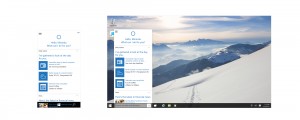 When Microsoft announced Windows 10, back in September 2014, it was a company on a mission. Executive Vice President Terry Myerson described its purpose as follows on the Windows Blog:
When Microsoft announced Windows 10, back in September 2014, it was a company on a mission. Executive Vice President Terry Myerson described its purpose as follows on the Windows Blog:
“One way to look at it is that Windows is at a threshold :-). It’s time for a new Windows. This new Windows must be built from the ground-up for a mobile-first, cloud-first world. This new Windows must help our customers be productive in both their digital work and their digital life. This new Windows must empower people and organizations to do great things.”
Or, as I would put it, “Microsoft skips from Windows 8 to Windows 10 to make sure it stays relevant.”
Fast forward to January 21, when Myerson brought together a group of Microsoft followers and Windows insiders for a couple of hours to go through the distinguishing features of the latest “build” of the OS. Acknowledging the importance of Intelligent Assistance, his list of new features of Windows 10 led off with the statement that “you’ll see Cortana as never before.”
Indeed, as presented by Microsoft these days, Cortana is positioned to be the highly personalized, human-like front-end to all of Microsoft’s software, services and devices. It will be a highly intuitive and anticipatory supporter of search, productivity, entertainment and mobile software and hardware. In addition, as Apple does with the Continuity feature integrated into both the iOS and OSX operating systems to enable iPhones and iPads to share information and support activities with MacBooks and other Apple computers, while remaining “true to their form factors,” Microsoft uses a feature called Continuum, to do the same.
Microsoft’s design is to make Windows apps and functions “work naturally across any device that you might use.” In many of these instances, the process starts with simply saying “Hey Cortana.” This natural interface works in 7 languages and leverages the power of the Bing search engine. Yet, in a move that Apple has yet to take on as part of Continuity and Siri, Microsoft has moved the Cortana experience to the PC where it appears in the familiar Task Bar and can be invoked with a click, or by saying “Hey Cortana.”
Joe Belfiore, who demonstrated Cortana on the PC, also mentioned that Cortana could spontaneously “pop up” from the task bar to make an important announcement or make a helpful suggestion. In these instances, Cortana is informed both by input that the PC’s user has voluntarily provided through notes and calendar entries and by the individual user’s interests, inferred from frequent searches, content of messages or other sources. In this respect it is much like GoogleNow on mobile phones.
Critics of Microsoft have already pointed out the similarities between the spontaneous Cortana, with its helpful hints, and the much-ridiculed “Clippy” desktop assistant. Indeed, Microsoft anticipated as much as early as April 2014 when its developers included an “easter egg” homage to Clippy as a cheerful Cortana provided relevant answers. At this point Belfiore took pains to explain how Cortana is designed to be a “trusted personal assistant.” Unlike Clippy, which treated everyone the same, it bases responses on what it knows about each individual user.
That’s the “personal” part. As for the “trusted” part, Cortana gives each person a modicum of control over what he or she is revealing or making available to the intelligent assistant. The metaphor in use is a “notebook” that Cortana keeps on each user. For their part, users can go into the notebook at any time to see what info Cortana has gleaned about them in the course of their regular activity on Websites. They can add new interests manually or, more importantly, they can remove items if, as Belfiore put it, “if she’s learned them incorrectly or I simply don’t want her to know those things.”
All of these items are available on a Cortana Home page, where they illustrate such things as flights being tracked, sports schedules or other items from a calendar or appointment book. More importantly, Belfiore showed that moving Cortana to the PC was more than simply bringing the phone experience to a desktop or laptop. As he put it, the developers “taught Cortana about the PC.” It can be used to find items in the PC’s directory in natural language. It can, for instance, find documents presentations or photos; launch apps and even find new apps in the correct online store.
Cortana on the PC provides each user with the ability to use spoken words (or natural language text input) to control media players or video games. Users can also interrupt what their doing to dictate a message or email. Belfiore, rather hyperbolically, calls it “the world’s most personal digital assistant” thanks largely to its “speech interaction model.” I’d call it a big step to making the conversational or “natural” user interface more compelling across multiple devices and form factors.
It’s a giant step toward keeping Microsoft relevant in a world where its direct competitors – especially Apple, Amazon, Facebook and Google – are flexing their mobile-first muscles.
Categories: Intelligent Assistants

 NiCE Interactions 2025: Agentic AI, Better Data, and a Whole Lot of Partnership
NiCE Interactions 2025: Agentic AI, Better Data, and a Whole Lot of Partnership  Getting It Right: What AI Agents Actually Mean for Customer Support (Webinar)
Getting It Right: What AI Agents Actually Mean for Customer Support (Webinar)  Beyond the Basics: How AI Is Transforming B2B Sales at TP
Beyond the Basics: How AI Is Transforming B2B Sales at TP  Five9 Launches Agentic CX: Toward AI Agents That Reason and Act
Five9 Launches Agentic CX: Toward AI Agents That Reason and Act